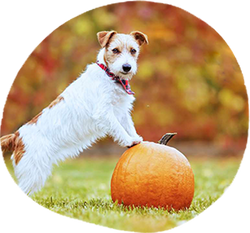No Products in the Cart
Dog Arthritis and Weight Management - With Dr. Conway

Hi Guys!
Today we’re diving into a touchy topic!
Drumroll please…
FOOD!
While preparing this article, I stumbled upon a recent study.
Did you know that 60% of people with overweight dogs think their dog's weight is ideal? Considering that 58% of dogs in the U.S. are overweight, that’s more than 1 in 3 pet parents who might not even realize it.
I know what you’re thinking – "That’s not me!"
But trust me, even two of my mom’s cats carry a little extra weight. And every time I mention it, she says I’m exaggerating – I’m not.
Long story short: this summer, we finally got them to slim down – yihaa!
But enough about my mom’s cats! Today, we’re talking about dogs, weight, food, and arthritis.
I’m Dr. Jeremy, a vet and cofounder of Jope, and I’m today with Dr. Conway, veterinary nutritionist and cofounder of Vital Vet. We’ll be your guide through the questions you’re probably wondering about! So, let’s dive into them!
How can I tell if my dog’s weight is ideal?
Ah! That’s a great question! Looking for the vet’s secret tip, aren’t you?
Here’s a simple trick: run your hand along your dog’s ribs (just behind the elbow is best)—if you can feel the ribs without pressing hard but can’t see them, your dog’s likely at a good weight.
The ribs should feel like the knuckles of your fist when you make one.
If you need to push to feel the ribs, it’s time to consider a weight loss plan.
Also, look at your dog from above; their waist should narrow, and from the side, there should be a slight tuck-up—resembling an hourglass shape.
Vets usually use the Body Condition Score (BCS), a scale from 1 to 9, where 4 or 5 is ideal.
If you’re unsure, your vet can guide you based on your dog’s breed and body structure.
Want to get started? Go visit this resource from the American Animal Hospital Association.
What are the dangers of excess weight in dogs?
Carrying extra weight means more than just a few extra pounds—your dog also carries increased health risks.
Fat cells release inflammatory cytokines, which can worsen conditions like arthritis. Plus, being overweight can increase the risk of heart disease, diabetes, and joint issues.
Extra fat leads to inflammation, creating a negative cycle, especially when it comes to joint problems. Keeping your dog lean is one of the best ways to ensure they stay healthy and enjoy a longer, happier life.

How does arthritis affect joints compared to a healthy joint?
In a healthy joint, smooth movement is possible because of the cushioning provided by cartilage and the lubrication from joint fluid. In an arthritic joint, though, things don’t move as smoothly:
- Cartilage breaks down, causing painful friction between bones.
- Inflammatory substances build up in the joint fluid.
- Ligaments surrounding the joint become inflamed.
- The joint capsule thickens, resulting in stiffness.
- Bony growths, or osteophytes, develop, leading to more pain.
This combination results in stiffness, pain, and limited mobility. If your dog seems slower or struggles to get up, arthritis could be the cause, and your vet can help you explore solutions.
How should I adjust my arthritic dog’s diet?
Another excellent question! Diet is key to managing arthritis.
EPA & DHA
Your first focus should be on EPA and DHA, two Omega-3 fatty acids that help reduce inflammation and support joint health. Ask your vet about the right dose for your dog.
Typically, a starting point is 120 mg of EPA + DHA per kilogram of body weight per day.
To calculate this, divide your dog’s weight in pounds by 2.2. For example, a 50lb dog weighs about 22.7 kg:
22.7 kg x 120 = 2,727 mg of EPA + DHA per day.
Ensure the product you choose specifies EPA and DHA dosages, not just total omega-3s.
Start with ¼ of the dose and increase gradually to avoid loose stools. Always consult your vet before starting, and remember to stop omega-3 supplements before any surgery.
You may need a concentrated product, like those from Veterinary Recommended Solutions or Nordic Naturals, to avoid issues like fishy odors and soft stools.
Glucosamine?
While glucosamine has been popular, recent studies suggest it’s not as effective as once thought.
“The results of the present meta-analysis led to the conclusion that chondroitin-glucosamine nutraceuticals should not be prescribed in canine or feline OA.” – Barbeau et al. 2022
UC-II® collagen?
A newer option is UC-II® collagen, which has shown improvements in joint function in both healthy and arthritic dogs.
UC-II has outperformed glucosamine in two studies and is becoming more common in veterinary recommendations. I recommend Jope for a high-quality UC-II supplement.



Diet Control
It’s essential to manage your dog’s calorie intake to avoid excess weight, as arthritis and extra pounds don’t mix well. A high-protein, low-calorie diet supports muscle and joint health. If your dog is overweight, a veterinary-prescribed diet plan is necessary to prevent nutrient deficiencies. Reducing calories by 25% alone can lead to muscle loss, worsening mobility.
For severe arthritis, combine weight management with supplements, medication, and possibly acupuncture. A veterinary rehabilitation practitioner can also create a treatment plan to help your dog feel better.
What can I cook for my dog with arthritis?
If you enjoy cooking, or your dog has specific dietary needs, I can help! I love designing personalized recipes that meet your dog’s health goals. For a consultation, feel free to schedule one here: https://danielle-conway.clientsecure.me or send us an email at info@vitalvetnutrition.com.
Be careful with many off-the-shelf fresh diets—they’re often high in calories and can cause weight gain. Let’s discuss fresh, low-calorie, joint-friendly options tailored to your dog’s needs.

How can I help my dog maintain a healthy weight?
This is a common question from pet parents! Here’s a step-by-step guide:
- Control portions: Weighing out food on a gram scale is the best way to control portions and takes just a few minutes for the whole week.
- Use food toys: You don’t need to serve meals in a bowl—hide food in toys to stimulate your dog mentally while controlling their weight. It’s like dog Sudoku!
- Choose low-calorie treats: Treats should be no more than 10% of daily calories. Baby carrots and green beans are great, low-calorie options.
- Avoid table scraps: These add unnecessary calories.
- Weigh your dog often: Keep an eye on their progress.
- Be consistent: Long-term weight management relies on regular habits.
What if my dog is already overweight?
If your dog is overweight, don’t stress! You can help them get back on track.
- Find their ideal weight: Your vet can help determine this using the Body Condition Score (BCS).
- Cut back on treats: It’s tempting, but they’ll enjoy treats more once they’re back at a healthy weight.
- Switch diets: You can either prepare a home-cooked, low-calorie diet or switch to a veterinary-prescribed weight loss food.
- Weigh regularly: Slow and steady is the best approach—aim for 1-2% weight loss per week.
For more info, consult the American Animal Hospital Association’s Weight Management Guidelines.

How can I support my dog’s joints?
Hydrotherapy and low-impact activities like swimming are excellent for dogs with arthritis or those overweight.
Supplements with proven ingredients like UC-II collagen and EPA & DHA are also helpful. A product like Jope offers comprehensive joint support and is made with organic ingredients and third-party testing.
An orthopedic bed can also help your dog stay comfortable. Always consult your vet for the best joint health strategy.
Caring for your dog’s weight and joint health doesn’t have to be overwhelming. Simple, consistent changes—like managing their diet, keeping them active, and incorporating the right supplements—can make a big difference in their overall well-being. Whether it’s adjusting their portions, finding low-impact activities, or choosing the best joint support, these steps will help your furry friend live a healthier, more comfortable life. And remember, your veterinarian is always the best resource for personalized advice to keep your dog at their best.
FAQs
How does dog arthritis start?
Arthritis in dogs typically begins due to joint inflammation and cartilage deterioration, which may arise from various factors including:
- Aging: Natural wear and tear of joints.
- Genetics: Breed predispositions (e.g., Labrador, German Shepherd, Corgi).
- Joint injury or trauma: Previous injuries can accelerate arthritis development.
- Developmental conditions: Such as hip or elbow dysplasia, causing abnormal joint structure and increased stress on joints.
- Overweight: extra pounds will add to the joints and fat cells are pro-inflammatory.
Early intervention through veterinary-recommended supplements like Jope Hip & Joint Dog Chews containing UC-II® collagen can help manage joint health, slow progression, and maintain joint comfort and function.
What causes arthritis to flare up in dogs?
Common triggers of arthritis flare-ups in dogs include:
- Cold or damp weather: May exacerbate stiffness and joint discomfort.
- Excessive physical activity: Overexertion or high-impact exercise stresses joints.
- Excess weight: Additional body weight significantly increases joint strain and inflammation.
- Inactivity or prolonged rest: Can result in stiffness and decreased flexibility.
- Inadequate joint care or lack of supplementation: Missing supportive joint nutrition can worsen symptoms.
Managing flare-ups involves keeping your dog warm, maintaining moderate, consistent activity, ensuring proper weight management, and providing daily joint support through supplements formulated with UC-II® collagen and omega-3 fatty acids, such as Jope Hip & Joint Dog Chews.
What are your tips for controlling arthritis pain in dogs?
Veterinarian-recommended tips for managing arthritis pain in dogs include:
- Maintain healthy weight: Reduces joint stress significantly.
- Daily joint supplements: Use clinically proven ingredients such as UC-II® collagen, omega-3 (EPA and DHA), and curcumin (found in Jope Hip & Joint Dog Chews).
- Low-impact, consistent exercise: Gentle walks, swimming, and hydrotherapy help strengthen muscles without overloading joints.
- Comfortable environment: Orthopedic beds and non-slip flooring reduce joint discomfort.
- Regular veterinary assessments: To adjust care plans and medication as needed.
How can I help my overweight dog lose weight safely?
Veterinarian-approved safe weight loss strategies for dogs include:
- Calorie-controlled diet: Veterinarian-formulated weight-loss diets help achieve safe and steady weight reduction.
- Portion management: Precisely measure daily food servings.
- Moderate daily exercise: Gentle walks, swimming, and controlled activities tailored to your dog's abilities.
- Healthy treats: Choose low-calorie treats like carrots or green beans, or commercial ultra low-calorie.
- Regular veterinary check-ups: Monitor weight loss progress to ensure healthy and safe reduction.
Can arthritis cause a dog to lose weight?
Yes, arthritis can indirectly lead to weight loss if pain or joint discomfort causes reduced appetite, decreased mobility, or reluctance to move to feeding areas-this is generally a sign of advanced arthritis, and you must absolutely check with your vet. However, arthritis more commonly leads to weight gain due to reduced activity. Sudden or significant weight loss should be promptly evaluated by your veterinarian to rule out other underlying health conditions and to ensure appropriate management. Regular supplementation and veterinary guidance can help control symptoms, maintaining overall health and mobility.










Leave a comment